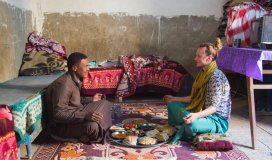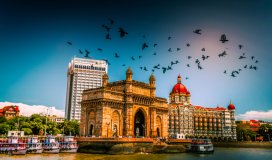Explore India with The Vibrant Colours of Holi!

If you want to explore the shades of India, the festival of Holi lets you experience the same extensively. From food to music, and handloom clothes to spiritual connect, the Festival of Love offers a memorable experience to those visiting the Indian subcontinent. Marking the end of winters and onset of spring, the Holi celebrations take place in March (the Phagun month of Hindu calendar) for two days. While Holika Dahan (Chhoti Holi) is celebrated on the full moon evening with a bonfire, Rangwali Holi is played the next morning. The festival lets people subside their differences and resentments, and participate in celebrations drenched and painted in hues of yellow, pink, green and blue.
Interesting Holi stories

Holika Dahan is practised in the honour of Hindu god, Vishnu, and his follower Prahlada who was the son of King Hirnyakashyap. The king was the master of all demons and wanted everyone to worship him rather than Lord Vishnu. His own son did not agree to this. Hence, he appointed his sister Holika to kill his son. As Holika was blessed with a boon that fire cannot harm her, she conspired to burn Prahlada. But, she was burnt to death while Prahlada remained unharmed in the fire by Lord Vishnu’s grace. And, this marked the victory of good over evil.
It is also said Lord Krishna, another Hindu deity, was a dark-skinned child and in his youth, he fell in love with fair-skinned Radha. Owing to his complexion, he used to think would Radha and other young girls (Gopis) ever like him. Thus, his mother persuaded him to ask Radha to use her favourite colour on him. Thereafter, playful Radha and Krishna are symbolic of Holi in India. They also signify the romanticism in the festival for couples.

On this day, people visit friends and families, gather in parks and open areas. They apply vibrant dry colours called Gulaal on each other and play with water guns. Kids splash water balloons on each other. They sing songs and dance to the beats of drums popularly known as Dho”. Not just this, Holi delicacies such as Gujjiya, Puran Poli, Malpuaa and Kheer, as well as Thandai and the intoxicating Bhaang are relished by everyone. Indeed, the perfect weather and company of loved ones with such celebrations make the onset of spring blissful.
Read more – Activities in Holi for Kids

Rangwali Holi has many names in different parts of the country. A characteristic Lath Mar Holi is celebrated in Barsana town of Uttar Pradesh where men sing provocative songs and women hit them with long sticks called lathis. In Mathura and Vrindavan, the celebrations with water, dry colours, chanting Aartis and hymns continue till two weeks.
In Gujarat’s Dwarka, the town founded by Lord Krishna, Holi is celebrated with great pomp and show. On the first day of the festival, people light bonfire during the evening and also offer raw coconut and corn to it. The following day, Dhuleti is celebrated with water and colours and the music and dance events go on the whole day across the town. Also, clay pots full of milk and milk products are hung high and boys gear up to break it in the states of Maharashtra and Gujarat. This is Matki Phod tradition.

In Indian states of Punjab, Haryana, Himachal Pradesh and Rajasthan, Holi celebrations start with Holika Dahan followed by splashing colours and water the next morning. Further, the season of Rabi crop is celebrated by peasants in these states and females decorate the rural houses with colourful geometrical patterns in the verandah. They also sing Phagun songs as winters have come to an end. Notably, India being predominantly an agrarian country, for many farmers, this is time for Thanksgiving for a good harvest.
Interesting Holi celebrations

In Odisha, Holi is known as Dola. Here, the icons of Lord Krishna are replaced by Jagannath and offered colours. In West Bengal and Assam, Dol Jatra is practised wherein Radha and Krishna idols are decorated and placed on swings, and everyone dances around them.
In the southern states of India, Holi is celebrated differently. Children in Karnataka and Telangana collect money, wood, corn and rice weeks prior to Holi. All these are burnt on the night of Holika Dahan. It is known by different names here such as Kamadahan, Kamavilas and Kama Pandigai.In spite of so much diversity, the festival of Holi unites the whole country in the colours of love and brotherhood. The zone of Holi brings immense joy and incredible zeal to every heart. Indeed, it marks the best time to visit India.
Read More :10 Unusual Holi Traditions across India
festival | Holi celebrations | holikadahan

